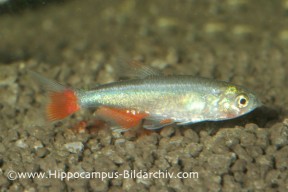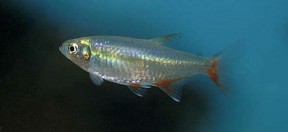Aphyocharax anisitsi
Bloodfin Tetra
Classification
Order: Characiformes Family: Characidae
Distribution
Described from Asunción, Paraguay and endemic to the Paraná River drainage in Brazil, Paraguay and Argentina.
Habitat
Streams, rivers and tributaries, particularly in areas shaded by floating or overhanging vegetation.
Maximum Standard Length
50 – 55 mm.
Aquarium SizeTop ↑
An aquarium with base dimensions of 60 ∗ 30 cm is suitable for a small group.
Maintenance
It looks most at home in a planted aquarium. Provide areas of dense vegetation, along with some open areas for swimming. Other décor can consist of twisted roots band pieces of bogwood.
Some floating vegetation will also be appreciated, as it tends to swim in the upper reaches of the tank. The tank must have a very tightly-fitting cover as it will jump on occasion.
Water Conditions
Temperature: 18 – 28 °C
pH: 6.0 – 8.0
Hardness: 54 – 447 ppm
Diet
Unfussy and will accept most dried, frozen and live foods.
Behaviour and CompatibilityTop ↑
Peaceful enough but may nip a little at long-finned or slow-moving tankmates. Try keeping it in a mixed shoal with other characids, along with Corydoras catfish and small Loricariids. Always keep it in a group of at least six as it’s a shoaling fish by nature.
Sexual Dimorphism
Males tend to be slimmer than females, and develop small hooks on some of their pelvic and anal fin rays as they mature.
Reproduction
Set up a separate small tank in which to spawn the fish with clumps of fine-leaved plants such as java moss to act as a spawning medium. Water parameters aren’t really critical, but very alkaline water should be avoided.
A small air-powered sponge filter completes the setup and will provide adequate aeration. The fish should be conditioned in a group in a separate tank on a high quality diet of frozen and live foods.
When the females are noticeably full of eggs and the males are displaying their best colours, select the fattest female and best-coloured male and transfer them to the spawing tank.
Once they are in situ, continue to feed lots of live and frozen foods until you notice eggs. If the fish are in condition, this will probably be the following morning. The eggs are usually deposited among the plants, but aren’t adhesive, and many will fall to the tank floor or even float.
The adults should be removed post-spawning as they will eat them, given the opportunity. The eggs hatch in 24 hours or so, and after the tiny fry have used up their yolk sacs, they should be offered infusoria–type food for the first few days, followed by microworm and/or brine shrimp nauplii.
This is quite a fecund species considering its size, and you may end up with several hundred fry on your hands.
NotesTop ↑
A good beginner’s tetra, as it’s a hardy species that will adapt to a relatively wide range of conditions. In a well-insulated house it can even be kept in an unheated tank, although it won’t be as colourful as when kept in warmer water.
It’s also quite long-lived and captive specimens over ten years old are not unheard of.




December 26th, 2013 at 1:15 pm
“Peaceful enough but may nip a little at long-finned or slow-moving tankmates.”
Really? “MAY nip…?” I have 8 of these bad boys, and the trailing fins of my 8 platinum angelfish have been nipped in half! LOL